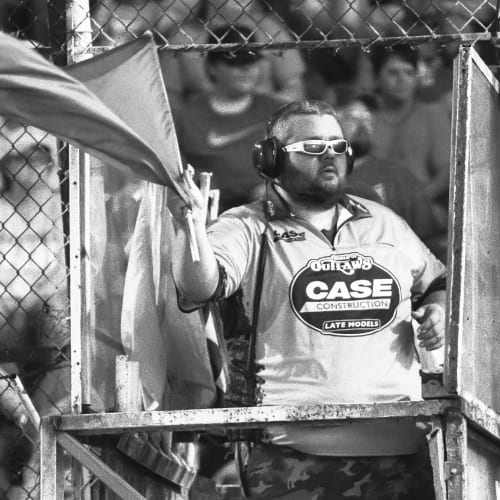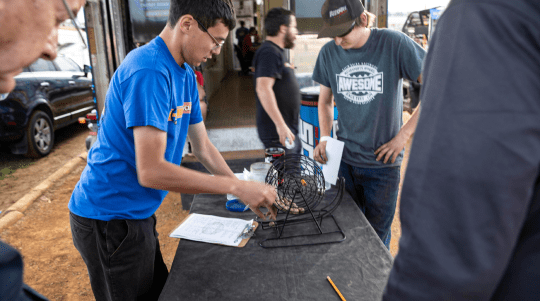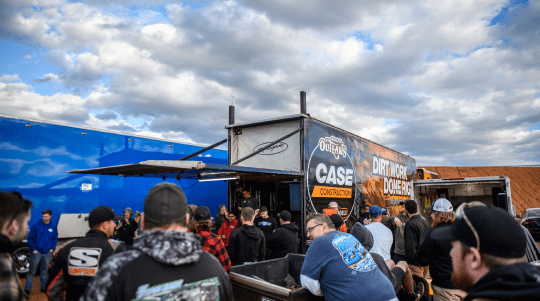

This is what it all boils down to. All the hype, preparation, planning, and testing come together on race day. It’s when the Drivers get to do what they love and put on a show for the fans. For the fans it is an evening of leaving their real world worries behind and enjoying time with family and friends as they watch the daredevil drivers of the World of Outlaws compete in one of the most intense forms of motorsports in the world.











The World of Outlaws NOS Energy Drink Sprint Car Series nightly race format is very similar to the race format at many dirt tracks around the country, but if you are more familiar with the race format of NASCAR or IndyCar, you may feel a little lost. Below is an outline of a typical race night for the World of Outlaws.
Prior to each night of racing, all World of Outlaws drivers and crew members attend a mandatory meeting conducted by Series Officials. The meeting outlines the night’s racing and any procedural changes that may be in place.
Group practice sessions of three or more laps (depending on track size) are run at speed for drivers to ensure their cars are ready for qualifying. Groups are determined by a draw that also determines the order for time trials.
Each driver runs two timed laps to determine where they will start in the Heat races. Any competitor who misses his spot in the qualifying order by more than two places is allowed one lap at the end of time trials with restrictions placed on how well they can officially be scored.
A series of 8- to 12-lap races (depending on the size of the track) that determine which cars will move on to the Feature or Last Chance Showdown. The top five cars in the Heats transfer when there are four heat races. If there are three heat races, then the top six transfer to the Feature. The number of Heats depends on the number of cars.
The top two finishers from each of the Heats qualify for the Dash, which determines their starting order in the Feature. The drivers draw for their place in the Dash lineup.
This is the final chance a driver has to make it into the Feature. The top 4-6 drivers (depending on car totals/heat races) in an 8 to 12-lap race (depending on track size) will transfer to the back of the Feature lineup.
The final race of the night determines the champion, who enters Victory Lane followed by the second and third-place finishers. These three constitute the Podium. Depending on the size of the track, the Feature usually ranges from 25 to 40 laps, which is predetermined and shared with the drivers and teams at the Drivers Meeting.

The World of Outlaws Late Model Series nightly race format is very similar to the race format at many dirt tracks around the country, but if you are more familiar with the race format of NASCAR or IndyCar, you may feel a little lost. Below is an outline of a typical race night for the World of Outlaws.
Prior to each night of racing, all World of Outlaws drivers attend a mandatory meeting, which is conducted by the World of Outlaws Competition Director and other Series officials. The meeting outlines the night’s racing events and any procedural changes that may be in place.
A practice session held prior to time trials that allows drivers and teams to fine-tune their cars. Hot laps are run in groups, with each driver assigned to their group by the pill draw that determined the order for time trials. Each driver is allotted three or more laps (depending on track size) at speed in order to ensure that their car is ready for qualifying.
Each competitor is given two timed laps to determine where they will start in a heat race. If a competitor misses their spot in the qualifying order (determined by a pill draw when each driver signs in at the Series control trailer) by more than two places, by rule they are relegated to one lap at the end of time trials and the best they can qualify is 50 percent-plus-one of the overall number of qualifiers no matter what qualifying time they post.
A 10-lap race that determines the drivers who will move on to the Feature or Last Chance Showdown. Depending on the number of heat races needed for the field of cars on hand, the top three, four or six finishers in each preliminary transfer directly to the Feature and the remainder of the finishers move on to the Last Chance Showdown. The heat races are aligned from the results of time trials – ie., the driver who earns the fastest-time starts from the pole position in the first heat, second-fastest starts from the pole in Heat 2, etc.
The top six to eight drivers (dependent upon the amount of heat races that take place) report to the front stretch of the racetrack before the Last Chance Showdown to redraw for starting positions. The starting positions will be within in the first three to four rows of the Feature event.
This is the final chance a driver has to qualify for the Feature. Depending on the number of heat races run, the top two, three or more finishers in a Last Chance Showdown will transfer into the night’s headline event. Last Chance Showdown distances are set at 12 laps. The two highest-ranked drivers in the Series points standings who do not qualify receive provisional spots to start at the rear of the Feature; track promoters have the option to add more provisional starters at their discretion.
The final race of the night which decides who is the overall winner of the event. The Feature is normally 40, 50 or 100 laps and the purses offered increase correspondingly with the length of the race. Caution-flag laps do not count toward the total laps completed. Additionally, the Feature must finish with at least two consecutive laps of green-flag racing.
In dirt racing, flags are used by race officials to communicate with drivers and other track personnel. Each flag has a specific meaning and serves as a way to signal various situations during a race.

The green flag signals the start of the race or the restart after a caution period. When the green flag is waved, it indicates that the track is clear, and racing can resume.

The yellow flag is displayed when there is a hazard on the track or an incident has occurred, and caution is required. Drivers must slow down, maintain their positions, and refrain from passing until the track is cleared and the green flag is displayed again.

The red flag is used when there is a serious incident or unsafe conditions on the track, and the race needs to be stopped immediately. All drivers must come to a complete stop on the track until the situation is resolved and further instructions are given.

The "Move Over" flag is essential for ensuring fair and safe racing, as it helps prevent unnecessary congestion and potential accidents on the track. When a driver sees the blue flag with a yellow stripe, they should be aware that they are about to be lapped by faster competitors and should move to the side of the track or take an alternative line to allow the faster drivers to pass.

The black flag is shown to a specific driver, indicating that they are being penalized or disqualified for a rule violation or unsafe behavior. The driver must leave the track and report to the pit area as instructed.

The white flag signifies that there is one lap remaining in the race. It informs drivers that the next flag they will see is the checkered flag, indicating the end of the race.

The checkered flag is displayed at the finish line, indicating the end of the race. The first driver to cross the finish line when the checkered flag is shown is the winner of the race.
“You wanted the best, you got ‘em four abreast!”
Those words by Johnny Gibson are an alert to World of Outlaws Sprint Car fans at every race they’re about to witness what the famed announcer calls “the most awesome sight in all of motorsports” – the Four-Wide Salute to the Fans.
Before the start of each Feature, the entire starting grid lines up four-wide for a parade lap to salute the fans and give them one of the most iconic photo opportunities in motorsports. It’s a spectacle that has been happening at every World of Outlaws race since the first in 1978 at Devil’s Bowl Speedway.
World of Outlaws founder Ted Johnson grew up going to Midget races in Wisconsin, even raced a little himself, and saw the Badger Midget Series do a four-wide parade lap. Wanting something unique and identifiable for his new World of Outlaws Sprint Car Series, he decided to implement the Four-Wide Salute at every event.
Twenty years later, enter Johnny Gibson as the Series’ official announcer. The Pennsylvania native joined the World of Outlaws full-time in 1997 and has served as “The Voice” of the Series ever since. However, his famous Four-Wide Salute call didn’t come until a couple years later.
“That’s something that developed over my first two-three years as an announcer, there was definitely no call to go with it,” Gibson said. “This thing evolved over a number of years; I didn’t do it all the time. I did it a couple times and thought, ‘OK, let’s maybe try this,’ for a while there was no music involved. It took a while for it to become what it is now.”
He knew he wanted something that could be identified with the World of Outlaws’ version of the four-wide and make it standout against all the other series that started adapting the tradition. Digging into his history with music, he found the perfect intro for his call.
“KISS was one of my first influences, one of the first things I remember about music that wasn’t just the music, like the showmanship and the stage show and the introduction to the band KISS: ‘You wanted the best, you got the best. The hottest band in the world, KISS!’”
From there, the iconic saying formulized and made the World of Outlaws’ Four-Wide Salute famous across the world.
“You wanted the best, you got ‘em four abreast. Often imitated, never duplicated. The Greatest Show on Dirt. The World of Outlaws NOS Energy Drink Sprint Cars!”
Your first visit to a dirt track can be intimidating if you don't know what to expect — or what to bring! Be sure to check the weather, and be prepared to maximize the excitement with this handy checklist.
.png?width=699&height=433&name=WRG-FAN101_Raceday-Checklist-Promo%20(1).png)

The most important thing to remember when at a dirt track, is that you're at a dirt track. There is danger all around you, but you will stay safe if you take the proper precautions. Pack your sunscreen (or winter gear) and ear plugs, hydrate, and always be alert!
